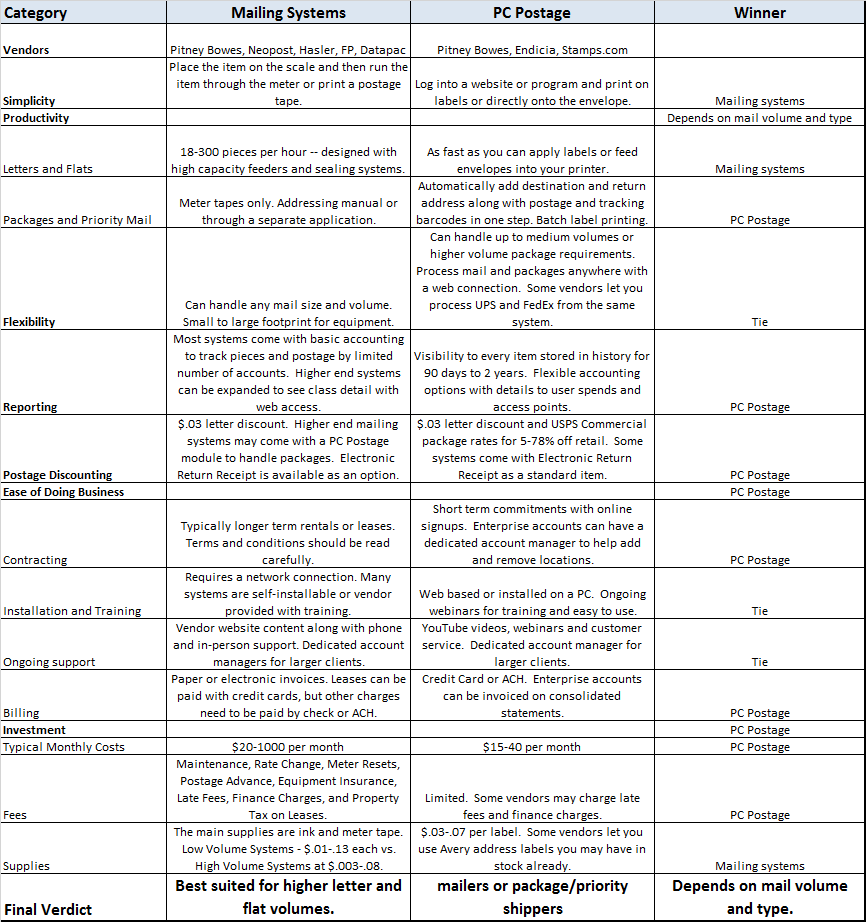Back in the July/August 2012 issue of Mailing Systems Technology, I had written an article comparing the differences between mailing systems (postage meters) and PC Postage. Despite almost five years passing, I felt it was a good time to revisit this topic for the following reasons:
1. Many of the postage meters in the US are connected with analog phone lines, and the equipment vendors are making a strong push to get these switched to network connections. This is driven by the telecommunication companies threatening to discontinue analog service.
2. Package volumes are increasing, and there are discounts available based on how the piece is electronically submitted to the USPS.
3. There have been technology changes that impact how mail gets processed.
Back in 2012, I focused on the functional differences of the two solutions. In this article, I plan to discuss the entire customer experience of working within these two types of postage solutions so you can see which one is a better fit for your organization.
ISSUES WITH ANALOG CONNECTIONS
Let’s start with the hard truth: It is going to be harder to get analog phone lines in the future. The mailing vendors are also not including analog modems with new equipment orders. Today, many organizations are spending $300-$600 per year on analog lines for their postage meter without other uses, and these charges can now be eliminated.
The biggest challenge we encounter when switching mailing systems from analog to network-enabled is firewall issues. The systems are basically designed to work when you plug them into the network jack, but many companies have security standards that require IT to get involved. This can delay the installation and require multiple departments to be engaged.
The key point to remember regarding the analog to digital connection issue is that since this transition is going to have to occur, it is a great time to explore your options for your future equipment needs. Figure 1 gives a complete comparison of PC Postage to mailing systems.

SIMPLICITY
Mailing systems are very easy to use. Walk over to the meter, place the item on the scale (or use the default postage amount), and run your mail. PC Postage requires that you log into a website or use a downloaded software program and either print postage onto label sheets or directly onto the envelope. Winner – Mailing System
PRODUCTIVITY
The only way to compare solutions is to break the mail into categories.
- Letters and Flats – Mailing systems are designed for higher production than PC Postage. They can run at 18-310 letters per minute (based on the type of system) and have optional sealers, integrated weighing scales, and automatic feeding modules. PC Postage can run as fast as you can either peel labels or feed envelopes into your printer. This software tool does have one significant advantage: an address list can be imported, and the destination address and postage can be printed in one pass. Winner: Mailing System
- Packages and Priority Mail – Postage meters can print a meter tape but still require addressing and manual applying of a tracking barcode. PC Postage prints one 4X6 shipping label with all information included. Address files can be imported for automatic label printing. Winner: PC Postage
FLEXIBILITY
Mailing systems are very flexible, with the ability to handle any mail volume, size, or class. The options range from a small unit the size of a desktop printer to up to 10 feet long based on volume capacities. PC Postage is flexible for different reasons. You can process mail or packages anywhere you have an internet connection. This is great for organizations with small offices or an agile workforce. They can also handle any volume of USPS packages, and some systems will let you compare and rate shipments with UPS and FedEx. Winner: Tie
REPORTING
Most mailing systems have basic accounting functionality that lets you track pieces and postage for a limited number of departments or cost centers. You can expand this at higher costs to web-based options that let you see the transaction detail. In this area, we feel PC Postage has a distinct advantage. Even with the lowest subscription levels, the transactions are stored for 90 days to up to two years (based on vendor), and the accounts can be expanded to 1000 or more. You can not only drill down to the cost center, but what a user generated for a given time period. Finally, you can control the access of your users to what levels of postage they can print, how much funds can be added, and what visibility they are allowed. This comes in especially helpful when you are running a large fleet of users. Winner: PC Postage
POSTAGE DISCOUNTING
Here is a listing of the discounts available for the different solutions:
- First-Class Mail – Metered – $.03 letter discount – This has been drastically increased from $.005 in 2016 and is available for both mailing systems and PC Postage.
- Electronic Return Receipt (for Certified Mail) – $1.30 savings over Retail Return Receipt – This can be added as an additional option for many mid- to large-sized mailing systems and is included at no cost for some PC Postage solutions.
- Commercial vs. Retail Rates – 16% average Savings Priority Mail, 11% Priority Mail Express – As of January 2015, the USPS required that to qualify for Commercial rates, you had to submit the address file and tracking information electronically. Postage meters can no longer get this discount unless they are accompanied by an additional PC Postage tool to do this submission. If you are a high-volume mailer, you may also qualify for an additional six percent average Commercial Plus savings that only can also only be offered through PC Postage.
- First Class Parcels – (Packages less than 16 ounces) – Seven percent average savings by converting from Retail to Commercial. Additional 30-62% savings for 13-15.99 ounce pieces that qualify for Commercial rates but would be forced to go Priority Mail if retail rates were being used through a postage meter. These discounts are only offered through PC Postage.
If you are a high-volume mailer and either use automation software with barcodes or a presort service for your letters and flats, you will want to continue using a mailing system to maintain those discounts. Winner: PC Postage
Ease of Doing Business
Our goal was to look at the main ways that you may interface with a postage solution provider to be able to see what is going to provide the best customer experience.
- Contracting – We find that PC Postage shines in this area mainly because there are fewer options. There is a monthly subscription fee along with some peripherals (scales and label printers) that will either come with the solution or can be purchased at a nominal amount. These agreements can be month to month or on an annual basis. This is compared to mailing systems, which are more complex and for longer periods. There are two core ways to order a mailing system:
--Leases – Typically three to five years in duration and locks you into a specific payment. There is very little flexibility if changes are needed, and fees and settlements will occur if early termination is required. Many vendors may also have evergreen clauses that automatically renew the term if they are not notified prior to the end of the agreement.
--Meter rentals – This is typically for low-end mailing systems only. Larger units can be purchased along with a meter rental and maintenance agreement. Annual increases and usage based rates may apply. These are typically on one- to three- year terms. Winner: PC Postage
- Installation and Training – As we discussed above, mailing systems will need to be installed on your network to do meter refills, download rates, and software updates. Low-end units are self-installable, and the onsite support is available for larger equipment. PC Postage is either accessed via the web or installed directly onto the PC. Even if web access is preferred, there may be a small applet required to control the printing functions. PC Postage is typically user-installed and easy to set up. Many of the vendors will run weekly webinars to help users get started. Both mailing systems and PC Postage providers will have decent websites and online videos to get users up and running quickly. Winner: Tie
- Ongoing Support – Both the mailing systems and PC Postage providers provide decent support. This includes detailed websites and 800 call center assistance. Both groups will offer service by replacement on low-volume equipment. The mailing systems providers will send onsite support to higher volume equipment. All providers will have dedicated account managers for larger level portfolios that can manage your day-to-day issues as they arise. Winner: Tie
- Billing – Overall, we find that PC Postage offers a superior billing experience to mailing systems, and this is mainly due to the streamlined and simplified nature of the offering. With mailing systems, you may have paper and electronic billing. Some items can be paid with credit cards while others require a check or ACH. PC Postage can be invoiced for rental, postage, or supplies on a credit card, ACH, or check. Both mailing systems and PC Postage solutions can bring multiple locations onto consolidated invoices, but from our experience this seems easier to set up with PC Postage. Winner: PC Postage
INVESTMENT
We will attempt to look at all the main costs for both solutions.
- Typical Monthly Costs – It is not a fair comparison because mailing systems have feeders and sealers that can drastically increase costs and are designed for higher volumes of letter mail. If you have lower letter volumes, you should consider the numbers below. Winner: PC Postage
--Mailing systems — $20-1000 per month — This assumes that units are rented or leased. Upfront costs will be required if they were purchased along with ongoing support agreements.
--PC Postage — $15-40 per month — Many systems include scales and label printers that can be purchased separately.
- Fees – PC Postage shines in this area because mailing systems can have many incremental charges, including maintenance agreements, parts and labor, rate changes, meter reset fees, postage advance fees, postage overage fees, equipment insurance (lease), finance charges, late fees, and property taxes (lease). Winner: PC Postage
FINAL VERDICT
There is no way that you can pick a winner because it all depends on your mail volumes and applications. As a rule of thumb, low-volume letter mailers who do any volume of packages may want to consider PC Postage. If most of what you send is letters and flats and you need feeding and sealing functions, mailing systems may be your best choice. Also, many medium- to high-volume letter mailers may add a PC Postage function along with their mailing systems to be able to get the discounts and package simplicity. The important aspect is to understand the differences between these options to select what is right for you.
Adam Lewenberg, CMDSS, MDC, President of Postal Advocate Inc., runs the largest Mail Audit and Recovery firm in the United States and Canada. They manage the largest mail equipment fleet in the world and their mission is to help organizations with multi-locations reduce mail related expenses, recover lost postage funds, and simplify visibility and oversight. Since 2013, they have helped their clients save an average of 60% and over $26 million on equipment, fee and lost postage. He can be reached at 617.372.6853 or adam.lewenberg@postaladvocate.com.















